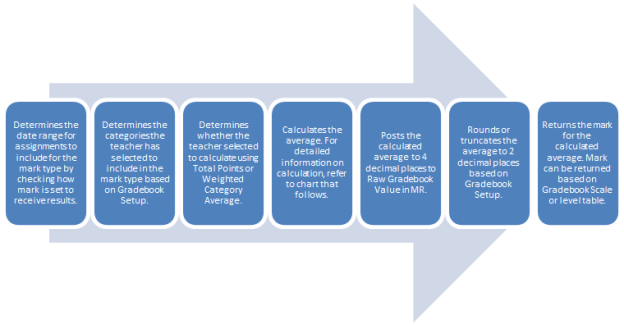Overview of Load Gradebook Averages Calculation
This topic includes illustrations of the basic flow of the calculation performed when teachers run Load from Gradebook or administrators run the Load Gradebook Averages option. For information on all options available to calculate marks, refer to Calculating Course Marks in Calculating Course Marks in eSchoolPlus.
When a teacher runs Teacher Access Center's Load from Gradebook or an administrator runs eSchoolPlus's Load Gradebook Averages option, the calculation:
First, calculates the marks for any mark type that receives results based on assignments for a period of time. In the Mark Types setup, these mark types are defined to receive Gradebook results based on marking period, term, at the end of the course, or year-to-date.
Then calculates the marks for any mark type that is defined to receive results from an average setup. In this case, the calculation is calculating the mark based on the marks students receive for other mark types. The calculation selects the average setup to use based on the Master Schedule's Average ID value for the course-section. These mark types are calculated last because the average calculation often includes mark types that receive results from Gradebook based on assignments for a period of time.
Refer to the following illustrations for information about the calculation process.
Calculating Gradebook Averages for Mark Types that Receive Results by Marking Period, Term, At End of Course, or Year-to-date

If Total Points Selected: | If Weighted Category Average Selected: |
|---|---|
| First, calculate average for each category.
Then calculate weighted average of all categories.
|
To determine the mark to return for a calculated average, the calculation checks if a student has a Gradebook Scale assigned.
If the student is assigned a Gradebook scale, then the calculated value is compared to the scale's minimum value for a mark to return the mark.
If the student does not have a Gradebook scale, then the calculated value is compared to the Average Using Value field in the level table. The calculation returns the mark where the Average Using value is closest to the calculated value. For more information, refer to the description of the Average Using Value field in Level Table Page
Calculating Gradebook Averages for Mark Types that Receive Results from Average Setup
This calculation uses the average setup that applies to a course-section to calculate a mark based on other marks. The processing is similar to the Mark Averages Calculation. For more information, refer to Overview of Mark Averages Calculation. When Load from Gradebook or Load Gradebook Averages is run, the calculation allows the teacher to override the weights used for marks, and marks are returned based on a Gradebook scale if a scale is assigned to the student.

To convert marks to numeric values, the calculation uses the level table's Average Using Value and Type fields. For more information on how the level table affects the calculation, refer to How the Level Table Average Using Fields Affect Mark Averages.
To determine the mark to return for a calculated average, the calculation checks if a student has a Gradebook Scale assigned.
If the student is assigned a Gradebook scale, then the calculated value is compared to the scale's minimum value for a mark to return the mark.
If the student does not have a Gradebook scale, then the calculated value is compared to the Average Using Value field in the level table. The calculation returns the mark where the Average Using value is closest to the calculated value. For more information, refer to the description of the Average Using Value field in Level Table Page
Tip
To check the average calculated for a mark type that receives results based on an average setup, use the Gradebook Average Setup Calculation Worksheet provided in the online help. In the online help's Content panel, select Mark Reporting > Learn About Calculating Marks > Gradebook Average Calculation Worksheet (PDF).
